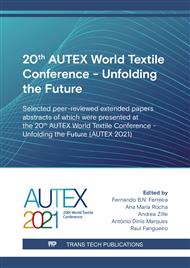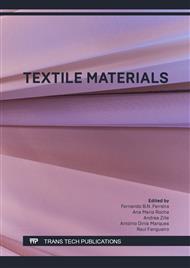[1]
B. Utebay, P. Celik, A. Cay, Effects of cotton textile waste properties on recycled fibre quality, J. Clean. Prod. 222 (2019) 29-35.
Google Scholar
[2]
R. Geyer, J.R. Jambeck, K.L. Law, Production, use, and fate of all plastics ever made, Sci. Adv. 3(7) (2017) e1700782.
DOI: 10.1126/sciadv.1700782
Google Scholar
[3]
Z. Kamble, B.K. Behera, Sustainable hybrid composites reinforced with textile waste for construction and building applications, Constr. Build. Mater. 284 (2021) 122800.
DOI: 10.1016/j.conbuildmat.2021.122800
Google Scholar
[4]
N.H.N. Do, V.T. Tran, Q.B.M. Tran, K.A. Le, Q.B. Thai, P.T.T. Nguyen, H.M. Duong, P.K. Le, Recycling of pineapple leaf and cotton waste fibers into heat-insulating and flexible cellulose aerogel composites, J. Polym. Environ. 29 (2021) 1112–1121.
DOI: 10.1007/s10924-020-01955-w
Google Scholar
[5]
I. Yalcin-Enis, M. Kucukali-Ozturk, H. Sezgin, Risks and management of textile waste, in: K.M. Gothandam, S. Ranjan, N. Dasgupta, E. Lichtfouse (Eds.), Nanoscience and Biotechnology for Environmental Applications, Springer, Cham, 2019, p.29–53.
DOI: 10.1007/978-3-319-97922-9_2
Google Scholar
[6]
S.S. Ali, T. Elsamahy, R. Al-Tohamy, D. Zhu, Y.A.G. Mahmoud, E. Koutra, D. Zhu, J. Sun, Plastic wastes biodegradation: Mechanisms, challenges and future prospects, Sci. Total Environ. 780 (2021) 146590.
DOI: 10.1016/j.scitotenv.2021.146590
Google Scholar
[7]
S.S. Ali, T. Elsamahy, E. Koutra, M. Kornaros, M. El-Sheekh, E.A. Abdelkarim, D. Zhu, J. Sun, Degradation of conventional plastic wastes in the environment: A review on current status of knowledge and future perspectives of disposal, Sci. Total Environ. 771 (2021) 144719.
DOI: 10.1016/j.scitotenv.2020.144719
Google Scholar
[8]
M. Martínez-López, G. Martínez-Barrera, R. Salgado-Delgado, O. Gencel, Recycling polypropylene and polyethylene wastes in production of polyester based polymer mortars. Constr. Build. Mater. 274 (2021) 121487.
DOI: 10.1016/j.conbuildmat.2020.121487
Google Scholar
[9]
S. Islam, G. Bhat, Environmentally-friendly thermal and acoustic insulation materials from recycled textiles, J. Environ. Manag. 251 (2019) 109536.
DOI: 10.1016/j.jenvman.2019.109536
Google Scholar
[10]
D.G.K. Dissanayake, D.U. Weerasinghe, L.M. Thebuwanage, U.A.A.N. Bandara, An environmentally friendly sound insulation material from post-industrial textile waste and natural rubber, J. Build. Eng. 33 (2021) 101606.
DOI: 10.1016/j.jobe.2020.101606
Google Scholar
[11]
I. Yalcin, T.Gok Sadikoglu, O.B. Berkalp, M. Bakkal, Utilization of various non-woven waste forms as reinforcement in polymeric composites, Textil. Res. J. 83(15) (2013) 1551-1562.
DOI: 10.1177/0040517512474366
Google Scholar
[12]
W. Baccouch, A. Ghith, I. Yalcin-Enis, H. Sezgin, W. Miled, X. Legrand, F. Faten, Investigation of the mechanical, thermal, and acoustical behaviors of cotton, polyester, and cotton/polyester nonwoven wastes reinforced epoxy composites, J. Ind. Text https://doi.org/10.1177/1528083720901864.
DOI: 10.1177/1528083720901864
Google Scholar
[13]
A.H. Hassanin, Z. Candan, C. Demirkir, T. Hamouda, Thermal insulation properties of hybrid textile reinforced biocomposites from food packaging waste, J. Ind. Text. 47(6) (2018) 1024-1037.
DOI: 10.1177/1528083716657820
Google Scholar
[14]
I. Susoeva, T. Vakhnina, A. Titunin, Y. Grunin, Water resistance of thermal insulation composites with cellulose-containing filler, E3S Web of Conferences 263 (2021) 01002.
DOI: 10.1051/e3sconf/202126301002
Google Scholar
[15]
T.N. Vahnina, I.V. Susoeva, A.A. Titunin, Thermal-insulation boards from fibrous plant wastes and urea-formaldehyde binder, Mag. Civ. Eng. 7 (2018) 136-147.
Google Scholar
[16]
H. Sezgin, M. Kucukali-Ozturk, O.B. Berkalp, I. Yalcin-Enis, Design of composite insulation panels containing 100% recycled cotton fibers and polyethylene/polypropylene packaging wastes., J. Clean. Prod. 304 (2021) 127132.
DOI: 10.1016/j.jclepro.2021.127132
Google Scholar
[17]
D. Duran, A research on thermal insulation properties of nonwovens produced with recycled jute and wool fibres. Tekst.ve Konfeksiyon 26(1) (2016) 22-30.
Google Scholar
[18]
S. Yukseloglu, M. Caliskan, Mechanical and thermal properties of wool waste fabric reinforced composites, Tekst. ve Muhendis 22(97) (2015) 14-20.
DOI: 10.7216/130075992015229703
Google Scholar
[19]
C. Yertutan and M. C. Bulbul, 2020, Dissertation Thesis, Istanbul Technical University, Istanbul, Turkey.
Google Scholar



